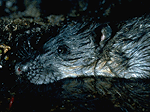Water rat

Common name: water rat
Scientific name: Hydromys chrysogaster
Family: Muridae
Conservation status: This species is listed as Least Concern in Queensland (Nature Conservation Act 1992).
Description
Many of us have had the nasty experience of hearing a house rat gnawing at night: this is an undesirable feral animal which can spread disease. In contrast, Australia's water rat, while in the same family, is an attractive native animal. The water rat is well adapted to its watery world. It has a relatively large streamlined body (body length up to 40 cm), small ears and eyes and abundant whiskers. The upperparts can vary from grey-brown to rich golden brown to blackish in colour, while the underparts are cream to golden-orange. Its hind paws are webbed and it has a flat furry tail that acts like a rudder and usually has a white tip. It has glossy water-repellent fur that protects it from the cold.
Habitat and distribution
The water rat is generally found in permanent fresh or brackish water, including freshwater lakes, streams, swamps, dams and urban rivers. It is one of only two Australian mammals living in fresh water (the other is the platypus).
The water rat has a wide distribution and can be found in Queensland, New South Wales, Victoria, Tasmania, the southern coast of South Australia, and coastal regions of Western Australia and the Northern Territory.
Life history and behaviour
The water rat spends most of its day in creek-bank burrows, but is mostly active around sunset when it comes out to feed, although it has also been known to forage during the day. It builds a grass-lined nest at the entrance to its burrow which is usually hidden among vegetation and built at the end of tunnels in banks of rivers and lakes.
Males are territorial and in areas with high population densities, it is common to see water rats with damaged tails as a result of fights defending their areas. The water rat is a fierce hunter, favouring tree-roots on river banks as regular feeding spots. It forages by swimming underwater and feeds on a wide range of prey including large insects, plants, crustaceans, mussels, fish, and small mammals and water birds.
Breeding can occur throughout the year, however most breeding occurs from spring to late summer. Studies have identified that social factors, individual age, and climate can also influence the time of breeding. Females usually breed when eight months old and can have up to five litters, each with three to four young each year. Young gain independence after eight weeks (Olsen 1995).
Threatening processes
The water rat has adapted well to living with humans. It was formerly hunted for its fur, but it is now a protected species in Australia and populations appear to have recovered from the effects of hunting. However, current potential threats to the species include:
- Habitat alteration as a result of flood mitigation, urbanisation and swamp drainage.
- Predation by introduced animals such as cats, foxes and some native birds of prey.
- The young are also vulnerable to predation by snakes and large fish (Olsen 1995).
What can you do to help this species
- Protect water rat habitat by leaving vegetation around watercourses to prevent bank erosion and maintain healthy waterway ecosystems.
- Further studies into the taxonomy of this species are needed.
Further information
CSIRO. 2004. Factsheet: Water for a healthy country - Taxon attributes profile – Hydromys chrysogaster, water rat.
Lee, AK 1995. The action plan for Australian rodents. Australian Nature Conservation, Agency, Canberra.
Menkhorst, P & Knight, F 2001. A field guide to the mammals of Australia. Oxford University Press, Melbourne.
Stranham, R 1983. Australian Museum Complete Book of Australian Mammals Angus and Robertson, Sydney.
Watts, CHS & Aslin, HJ 1981. The rodents of Australia. Angus and Robertson. Sydney.
Reference
Olsen, PD 1993. Water rat Hydromys chrysogaster. Pp 367-368 in the Australian Museum Complete Book of Australian Mammals (R.Strahan, ed). Angus and Robertson, Sydney.


